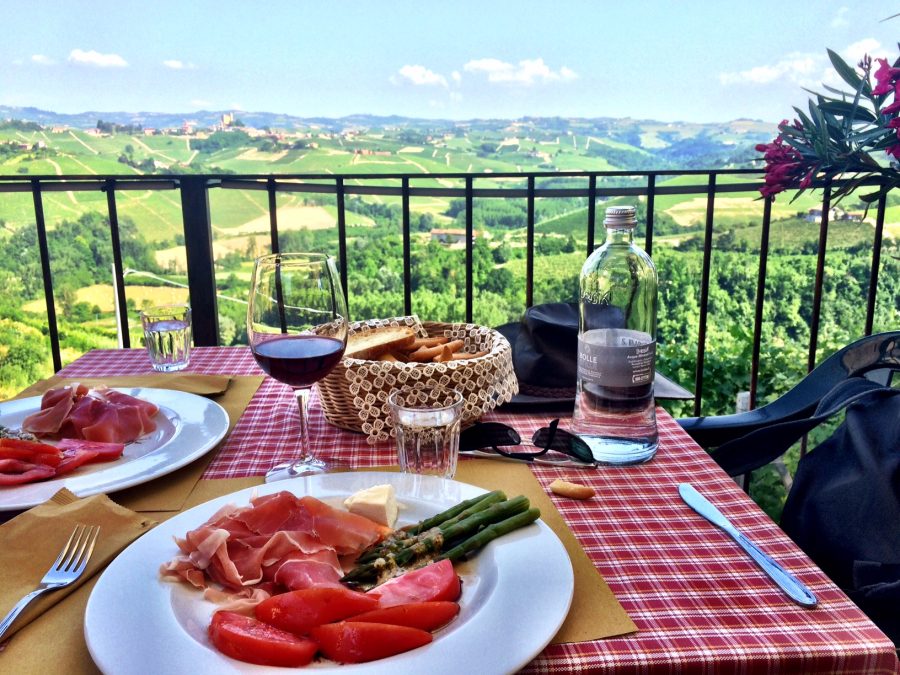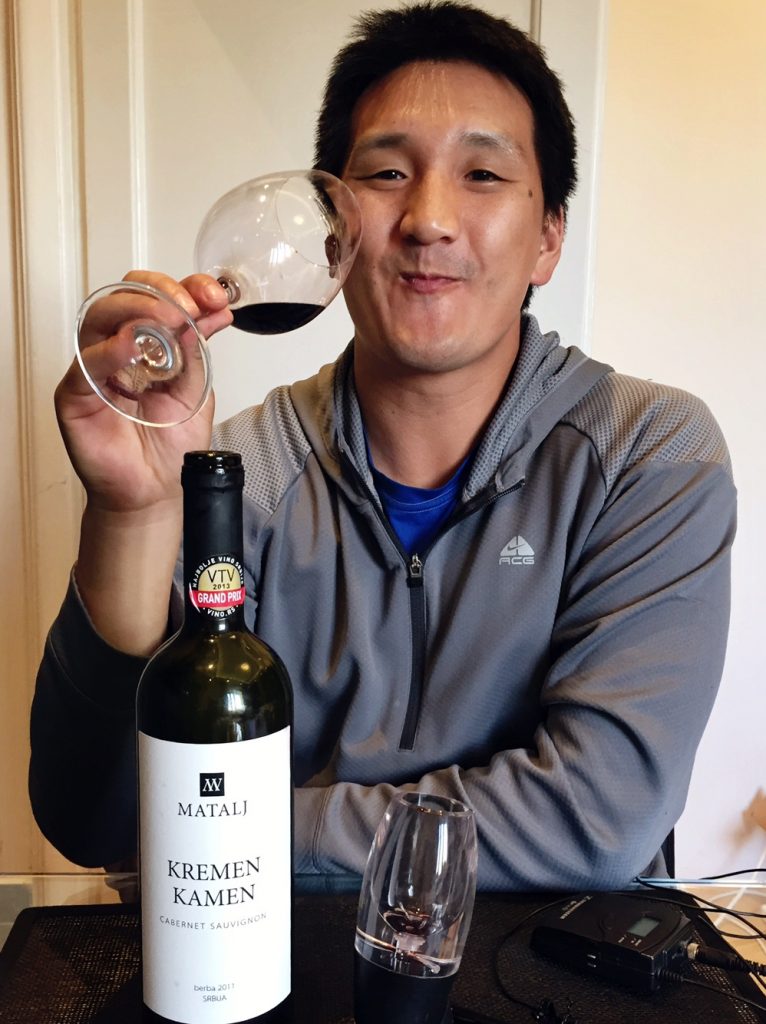Wine Travel and Lessons in Wine
(Reading Time: [est_time]) My apologies, it has been a while since we last posted any original material. Our focus lately has been on our YouTube channel and merging The Blue Roster and Exotic Wine Travel. There are

(Reading Time: 6 minutes)
My apologies, it has been a while since we last posted any original material. Our focus lately has been on our YouTube channel and merging The Blue Roster and Exotic Wine Travel. There are many exciting projects in the works, so stay tuned. This last year has been an incredible foray into the world of wine and I’d like to share a small snippet of what we’ve learned.
It has been exactly one year since Charine and I left our careers in Singapore to pursue a mobile lifestyle. We started out traveling for leisure but found ourselves gravitating towards food and wine. Last year, we started our trip with my parents through the Lake Geneva wine region and the rolling hills of Tuscany. Charine and I continued the wine journey as we went through Barolo, Barbaresco, and Sicily, Douro in Portugal, and the famous wine region Rioja in Spain. We went further, into the less-known wine regions, and found ourselves eating grossly underrated food unfortunately paired with less than stellar wines across the Anatolian Plateau. We tasted wine as it probably was centuries ago in the Republic of Georgia and bumped elbows with the wine renaissance taking place in post-Soviet Armenia.
After stopping back in Asia and realizing that our focus moving forward will be on wine, we discovered a whole new (or old) wine world in Ex-Yugoslavia. From the surprisingly good wines of Serbia, to the mammoth sized wineries in Macedonia, and on to the excellent wines of Bosnia Hercegovina before seeing the largest single plot of vineyards in Montenegro. The remaining time in Ex-Yugoslavia was spent in the tourist hot spot, Croatia. The three weeks through Croatian’s regions of Dalmatia and Istria were filled with brilliant food and equally epic wines.
The last year has put my palate to a lot of solid wine, plenty of great wine, and a lot of, shall I say, “shitty” wine.
After arriving in the USA from Ex-Yugoslavia, we met some old friends at an Armenian wine-tasting event and then took a short trip through the up-and-coming wine route in Virginia. While in the tasting room, as we were tasting our way through a large flight of wines, something clicked. This “something” was actually the culmination of a lot of thoughts that I would like to share.
WINE TRAVEL AND FOUR LESSONS IN WINE
1. Know What You are Drinking
When first starting to drink wine, I was a broke graduate student who picked most of his sub 10 dollar bottles off the super market shelves. The wine was usually terrible, I really, really wanted to like it, often trying to pick out the nuances in each different bottle. Fast forward eleven years and I now know that in the USA, almost all the wine on the supermarket shelves are from a handful of large companies stamping different labels on the bottles, lead by EJ Gallo and Constellation Brands.
You never heard of those brands? Well check out the websites of both companies HERE and HERE and see if you recognize any of the labels.
Most people solely sample these wines and deem wine as all the same and/or terrible – if you are only drinking that stuff, it is uniform and bland. I drank it for years, pretending to like it. Something kept me interested though and when you are passionate about a subject, answers tend to fall into your lap. So if you do like wine and want to know more, the most important thing is to hang onto that curiosity.
2. Trust Your Palate
The first time I drank wine that knocked my socks off was a carafe of table wine in Tuscany. I stuck my nose in the carafe and took in all the aromas. My two friends looked at me as if staring at a crazy person. I was hooked. Just a few years later I visited a friend in New Zealand. He opened a bottle of Shiraz from Margaret River. The wine was excellent and I smelled the empty glass for another twenty minutes after finishing.
You don’t need to be a wine expert or even an enthusiast. My father knows nothing about wine, nor does he care to, but he trusts his palate and he can easily discern the difference between average, good, and great wine. A lot of people who know nothing about wine can distinguish good from great wine just by tasting it. Even though there are differing preferences, many would be able to distinguish good-tasting food from bad . If you get out of your own head, it would be surprising that you too can enjoy many different types of wine.
Many people, including myself in the past, are intimidated by wine. But wine, at the end of the day, is just a beverage and we should treat it as such. The subtle nuances, aromas, flavors, and complexities are there for those who want it; but for other people, there is nothing wrong with treating it as a beverage to go with food.
One winemaker told me once, “You know, we like to look at wine, talk about it, smell it, but at the end of the day, wine was meant to be drunk.”
3. Winemaking is Complex
Growing up on a large-scale vegetable farm, I always dreaded the summers. While my friends were out playing and having fun, I was helping out on the farm. At that time, I hated it. Years have gone by and my father never pushed me into becoming a farmer. It’s ironic that getting onto this wine journey has brought me closer to my childhood memories.
Visiting small, boutique wineries is a familiar territory for me because fundamentally wine is an agricultural product – with those who make distinctive, hand crafted wines being farmers. Every time I step into a cellar, see workers sort grapes, or look at the bottling/packing equipment, it feels oddly familiar. Shaking a dirty hand is always a good sign to me when first entering a winery.
People do not realize the amount of effort that goes into farming and more specifically, growing grapes and making wine. The first difficulty is you are at the mercy of mother nature. When growing grapes with the goal of great wine, it becomes even more difficult because wine grapes need poor soil, deep roots, and the least amount of water possible. A struggling and weak grapevine is susceptible to pests, fungus and disease. It’s no wonder that winemakers treat their vines like delicate children.
When the harvest comes, it is important to harvest when ripeness is optimal and in dry conditions – if grapes are harvested after a rain, then the grapes will swell up and the whole year of effort could go to waste. Since most grapes are harvested in the fall when the rains start to come, picking season is a dance with the weather. After the harvest comes the intricacies of fermenting the grapes, soaking them in skins, putting wine into barrels to mature, then blending samples from different barrels to get the final product. After visiting hundreds of wineries, I am amazed that some producers can put a high-quality wine out for under twenty dollars – especially considering the cost of bottles and cork. Next time you fork out a little extra money for wine for that special occasion, don’t feel guilty or foolish. You are buying a piece of art, something made with passion, and something that you can enjoy with loved ones.
4. Critci Scores: Boon or Burden?
Wine Spectator, Robert Parker, Wine Enthusiast, International Wine Cellar, Decanter – if you start drinking wine more than casually, these names start to pop up. Many of the critics use the 100-point scale, first used by Robert Parker. It was something that most Americans can relate to as our marks throughout our school years are based on the same scoring system.By associating it with a measurement that we are familiar with, wine becomes less intimidating and easier to understand.
When I started drinking wine, scores merely stood for wine that wasn’t in my consciousness and/or budget. Growing up in the wine world, I was fortunate enough to sample better and better wine and with that, came more attention to the wine critics. Early on, with my lack of information and experience in wine, I will admit that critic scores meant everything to me. It didn’t matter who the critic was, if it was a 90+ point wine, it was worth trying. Soon it became an obsession to drink as many 90-point wines as possible, in order for myself to become a “validated” wine drinker.
Then the wine journey got serious. As I tasted highly rated wine and learned more about the “game” of the wine industry, scores started to matter less.
This was most evident during the last trip through the ex-Yugoslavian countries. During the three-month trip, Charine and I came across one winery in Serbia and one winery in Macedonia that had their wines rated by Robert Parker. With a large number of excellent examples coming from the region, we wondered how only two wineries were scored. It was soon evident that these two wineries were extremely well financed, which is a point that’s up to your own interpretation. But’s that’s not the main point.
The scored wines from those two wineries were good. However, there were much better examples, in my opinion, that were not scored at all. I don’t blame the wine critics though – how could they score all these wines when they are busy enough tasting wines from the numerous sough-after wine regions in France, Italy, Spain etc. In addition to that, critics are so well trained that many of them score wines based on the potential, specifically how the wines will taste like as they age. You have to remember that critics are people too, they have certain preferences and dislikes just like you and I, so what suits your taste may not always be their taste and vise versa.
Critic scores came into prominence because it gave the consumer confidence, but as you experiment and try more wine, you will develop your own preferences without the need for someone’s opinion. It is actually refreshing when you get to the point where you drink a wine scored by a critic and you don’t agree, and have the confidence to be OK with that. Once you take that step, you haven’t arrived, you have simple begun your real journey in wine.
What a journey it has been, I’ve just scratched the surface and what’s underneath looks promising.
Related
How to Evaluate Wine


